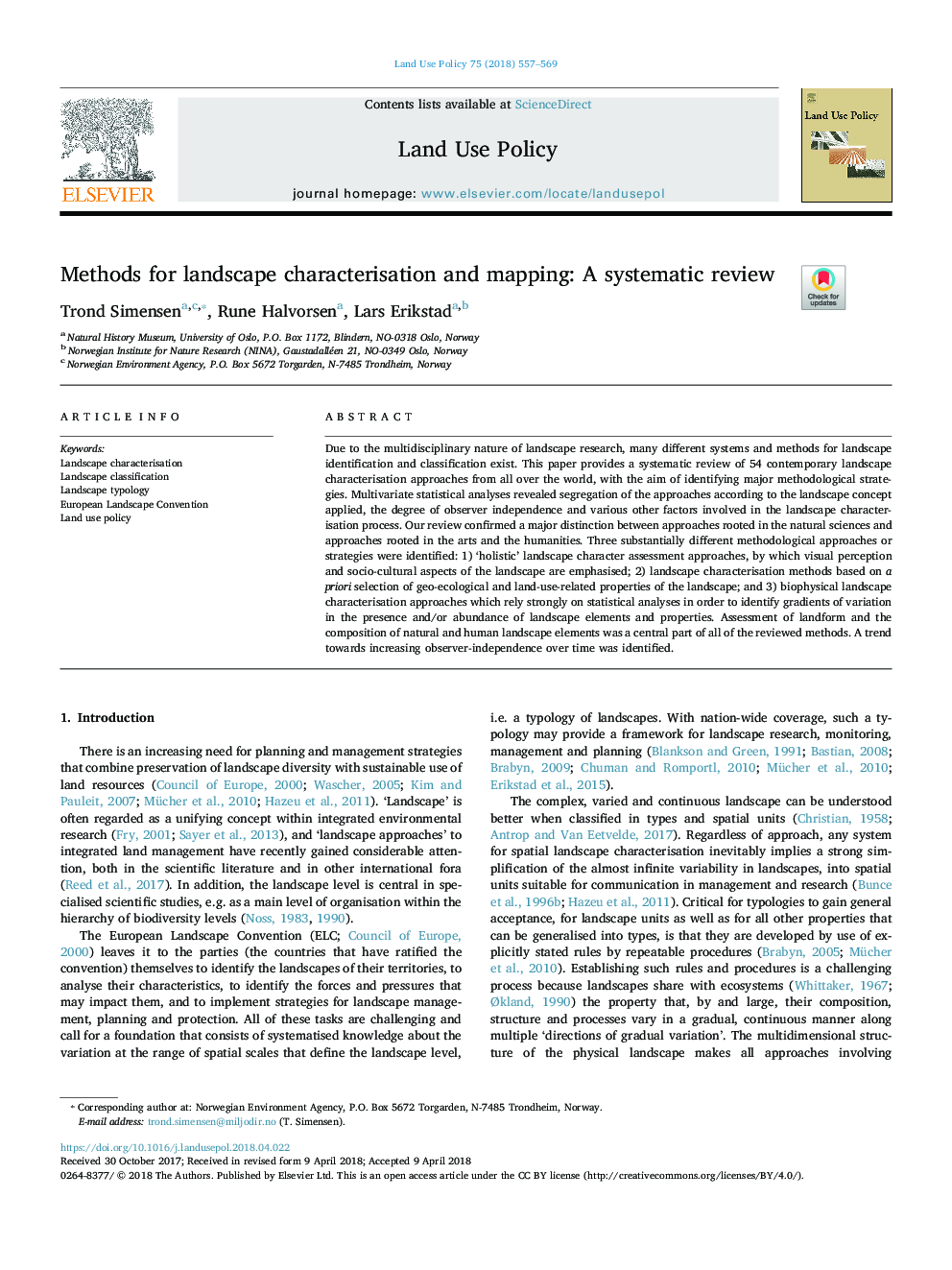| کد مقاله | کد نشریه | سال انتشار | مقاله انگلیسی | نسخه تمام متن |
|---|---|---|---|---|
| 6546439 | 1421808 | 2018 | 13 صفحه PDF | دانلود رایگان |
عنوان انگلیسی مقاله ISI
Methods for landscape characterisation and mapping: A systematic review
ترجمه فارسی عنوان
روش ها برای مشخص کردن و تعیین نقشه های چشم انداز: بررسی سیستماتیک
دانلود مقاله + سفارش ترجمه
دانلود مقاله ISI انگلیسی
رایگان برای ایرانیان
کلمات کلیدی
مشخصه چشم انداز، طبقه بندی چشم انداز، نوع ترسیم چشم انداز، کنوانسیون چشم انداز اروپایی، سیاست استفاده از زمین،
ترجمه چکیده
با توجه به ماهیت چند رشته ای مطالعات چشم انداز، بسیاری از سیستم ها و روش های مختلف برای شناسایی و طبقه بندی چشم انداز وجود دارد. این مقاله یک بررسی سیستماتیک از 54 رویکرد توصیف منظر معاصر از سراسر جهان را با هدف شناسایی راهکارهای روش شناختی عمده ارائه می دهد. تجزیه و تحلیل آماری چند متغیره نشان داد که جدایی روش ها با توجه به مفهوم چشم انداز اعمال شده، میزان استقرار ناظران و عوامل دیگر مختلف در فرآیند مشخصه چشم انداز مشخص شده است. بررسی ما یک تمایز عمده بین رویکردهای ریشه در علوم طبیعی و رویکردهای ریشه در هنر و علوم انسانی را تایید کرد. سه روش یا استراتژی روش شناختی متفاوت، شناسایی شدند: 1) رویکردهای ارزیابی شخصیت چشم انداز «کل نگر»، که بر آن، دیدگاه های بصری و جنبه های اجتماعی و فرهنگی چشم انداز تأکید می شود؛ 2) روش های تعیین مشخصات چشم انداز بر اساس انتخاب پیشینی از خواص مربوط به زمین شناسی و زمین کاربرد چشم انداز؛ و 3) رویکردهای مشخصه های دیدگاه بیوفیزیکی که به شدت بر تحلیل های آماری تأثیر می گذارد، به منظور شناسایی شیب تنوع در حضور و یا فراوانی عناصر و ویژگی های چشم انداز. ارزیابی شکل زمین و ترکیب عناصر منظره طبیعی و انسان بخش مهمی از همه روش های بازبینی شده بود. روند رو به افزایش ناظران - استقلال در طول زمان مشخص شد.
موضوعات مرتبط
علوم زیستی و بیوفناوری
علوم کشاورزی و بیولوژیک
جنگلداری
چکیده انگلیسی
Due to the multidisciplinary nature of landscape research, many different systems and methods for landscape identification and classification exist. This paper provides a systematic review of 54 contemporary landscape characterisation approaches from all over the world, with the aim of identifying major methodological strategies. Multivariate statistical analyses revealed segregation of the approaches according to the landscape concept applied, the degree of observer independence and various other factors involved in the landscape characterisation process. Our review confirmed a major distinction between approaches rooted in the natural sciences and approaches rooted in the arts and the humanities. Three substantially different methodological approaches or strategies were identified: 1) 'holistic' landscape character assessment approaches, by which visual perception and socio-cultural aspects of the landscape are emphasised; 2) landscape characterisation methods based on a priori selection of geo-ecological and land-use-related properties of the landscape; and 3) biophysical landscape characterisation approaches which rely strongly on statistical analyses in order to identify gradients of variation in the presence and/or abundance of landscape elements and properties. Assessment of landform and the composition of natural and human landscape elements was a central part of all of the reviewed methods. A trend towards increasing observer-independence over time was identified.
ناشر
Database: Elsevier - ScienceDirect (ساینس دایرکت)
Journal: Land Use Policy - Volume 75, June 2018, Pages 557-569
Journal: Land Use Policy - Volume 75, June 2018, Pages 557-569
نویسندگان
Trond Simensen, Rune Halvorsen, Lars Erikstad,
